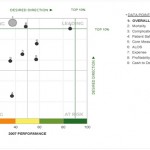Marketing Performance Management tools
Marketing has been for some time one of the core organizational functions. Especially in today’s competitive global economy, the marketing capability is vital for success. As a result, Marketing Performance Management is gaining importance on marketers’ agendas, from both improvement and accountability perspectives.
The Marketing Science Institute from USA has ranked marketing accountability, ROI (return on marketing investment) and MPMS (marketing performance management systems) among the top 10 priorities in marketing research since 2002 and as top-priority for 2008-2010 (Lamberti & Noci, 2010).
Marketing Performance Management has several dimensions, depending on the perspective of the measurement (whether it regards marketing results for the organization as a whole, or performance within the marketing department) and depending on the aspect under evaluation (whether it is branding, customer etc.).
Two of the most popular marketing performance measurement tools are:
- Marketing Scorecard – contains KPIs that the marketing function uses to assess performance of the department as an entity in itself. It outlines the objectives of the function and their corresponding KPIs, grouped by perspectives (such as the traditional Balanced Scorecard ones).
- Marketing Dashboard – contains KPIs that reflect the results of the marketing capability at organizational level, such as aspects related to the market position, customer analysis, brand dimensions etc. Marketing Dashboards can also be developed for specific aspects of the activities, such as Customer Dashboard or Brand Dashboard.
A Customer Dashboard can be organized around aspects such as, among others:
- Dynamics in customer portfolio (common KPIs would be: % New client ratio, % Customer retention etc.)
- Customer satisfaction (% Customer satisfaction with new products and services, % Customer complaints due to quality of services etc.)
- Customer Behavior (% Repeat customers, # Average lag time between customer purchases etc.)
- Profitability and cost analysis ($ Customer profitability, $ Average acquisition cost etc.)
Having these things clearly streamlined is very useful when organizing the Marketing Performance Management system and architecture, as it helps focusing on the most relevant aspects and organizing data in a structured and articulated manner.
References:
- Kennedy, N 2006, Google marketing principles
- Lamberti, L & Noci, G 2010, ‘Marketing strategy and marketing performance measurement system: Exploring the relationship,’ European Management Journal, vol. 28, pp. 139-152
- smartKPIs.com, Key Performance Indicator Examples in Marketing & Communications Functional Area
Image Source:
- Kennedy (2006)

Tags: Marketing performance, Marketing Science Institute, Performance in USA, Performance Management






